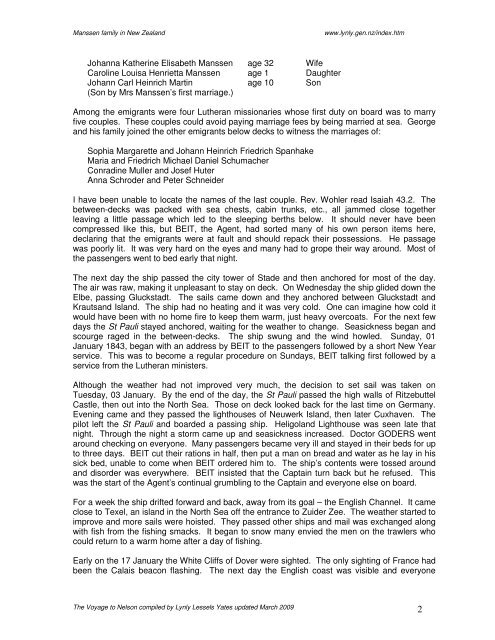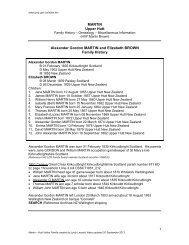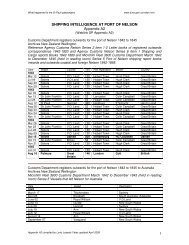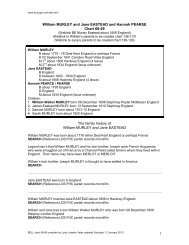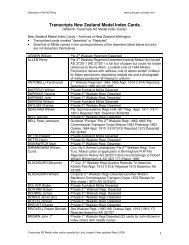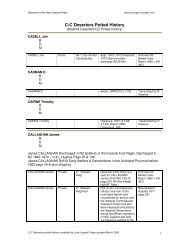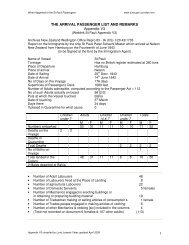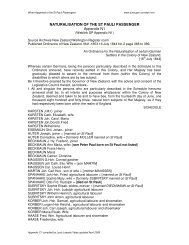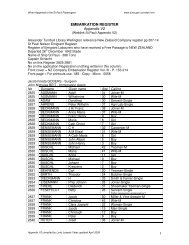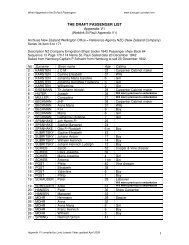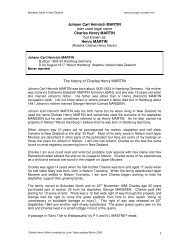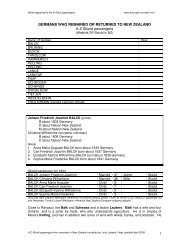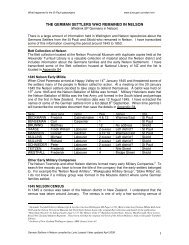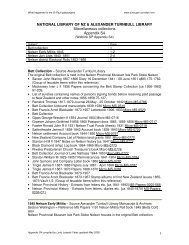The Voyage to Nelson
The Voyage to Nelson
The Voyage to Nelson
Create successful ePaper yourself
Turn your PDF publications into a flip-book with our unique Google optimized e-Paper software.
Manssen family in New Zealand www.lynly.gen.nz/index.htm<br />
Johanna Katherine Elisabeth Manssen age 32 Wife<br />
Caroline Louisa Henrietta Manssen age 1 Daughter<br />
Johann Carl Heinrich Martin age 10 Son<br />
(Son by Mrs Manssen’s first marriage.)<br />
Among the emigrants were four Lutheran missionaries whose first duty on board was <strong>to</strong> marry<br />
five couples. <strong>The</strong>se couples could avoid paying marriage fees by being married at sea. George<br />
and his family joined the other emigrants below decks <strong>to</strong> witness the marriages of:<br />
Sophia Margarette and Johann Heinrich Friedrich Spanhake<br />
Maria and Friedrich Michael Daniel Schumacher<br />
Conradine Muller and Josef Huter<br />
Anna Schroder and Peter Schneider<br />
I have been unable <strong>to</strong> locate the names of the last couple. Rev. Wohler read Isaiah 43.2. <strong>The</strong><br />
between-decks was packed with sea chests, cabin trunks, etc., all jammed close <strong>to</strong>gether<br />
leaving a little passage which led <strong>to</strong> the sleeping berths below. It should never have been<br />
compressed like this, but BEIT, the Agent, had sorted many of his own person items here,<br />
declaring that the emigrants were at fault and should repack their possessions. He passage<br />
was poorly lit. It was very hard on the eyes and many had <strong>to</strong> grope their way around. Most of<br />
the passengers went <strong>to</strong> bed early that night.<br />
<strong>The</strong> next day the ship passed the city <strong>to</strong>wer of Stade and then anchored for most of the day.<br />
<strong>The</strong> air was raw, making it unpleasant <strong>to</strong> stay on deck. On Wednesday the ship glided down the<br />
Elbe, passing Gluckstadt. <strong>The</strong> sails came down and they anchored between Gluckstadt and<br />
Krautsand Island. <strong>The</strong> ship had no heating and it was very cold. One can imagine how cold it<br />
would have been with no home fire <strong>to</strong> keep them warm, just heavy overcoats. For the next few<br />
days the St Pauli stayed anchored, waiting for the weather <strong>to</strong> change. Seasickness began and<br />
scourge raged in the between-decks. <strong>The</strong> ship swung and the wind howled. Sunday, 01<br />
January 1843, began with an address by BEIT <strong>to</strong> the passengers followed by a short New Year<br />
service. This was <strong>to</strong> become a regular procedure on Sundays, BEIT talking first followed by a<br />
service from the Lutheran ministers.<br />
Although the weather had not improved very much, the decision <strong>to</strong> set sail was taken on<br />
Tuesday, 03 January. By the end of the day, the St Pauli passed the high walls of Ritzebuttel<br />
Castle, then out in<strong>to</strong> the North Sea. Those on deck looked back for the last time on Germany.<br />
Evening came and they passed the lighthouses of Neuwerk Island, then later Cuxhaven. <strong>The</strong><br />
pilot left the St Pauli and boarded a passing ship. Heligoland Lighthouse was seen late that<br />
night. Through the night a s<strong>to</strong>rm came up and seasickness increased. Doc<strong>to</strong>r GODERS went<br />
around checking on everyone. Many passengers became very ill and stayed in their beds for up<br />
<strong>to</strong> three days. BEIT cut their rations in half, then put a man on bread and water as he lay in his<br />
sick bed, unable <strong>to</strong> come when BEIT ordered him <strong>to</strong>. <strong>The</strong> ship’s contents were <strong>to</strong>ssed around<br />
and disorder was everywhere. BEIT insisted that the Captain turn back but he refused. This<br />
was the start of the Agent’s continual grumbling <strong>to</strong> the Captain and everyone else on board.<br />
For a week the ship drifted forward and back, away from its goal – the English Channel. It came<br />
close <strong>to</strong> Texel, an island in the North Sea off the entrance <strong>to</strong> Zuider Zee. <strong>The</strong> weather started <strong>to</strong><br />
improve and more sails were hoisted. <strong>The</strong>y passed other ships and mail was exchanged along<br />
with fish from the fishing smacks. It began <strong>to</strong> snow many envied the men on the trawlers who<br />
could return <strong>to</strong> a warm home after a day of fishing.<br />
Early on the 17 January the White Cliffs of Dover were sighted. <strong>The</strong> only sighting of France had<br />
been the Calais beacon flashing. <strong>The</strong> next day the English coast was visible and everyone<br />
<strong>The</strong> <strong>Voyage</strong> <strong>to</strong> <strong>Nelson</strong> compiled by Lynly Lessels Yates updated March 2009 2


